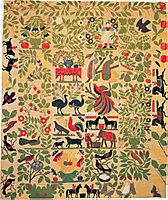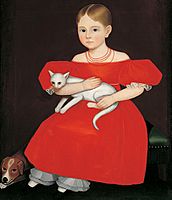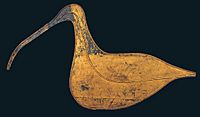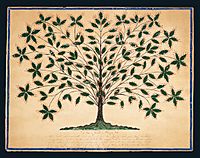American Folk Art Museum facts for kids
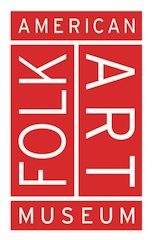 |
|
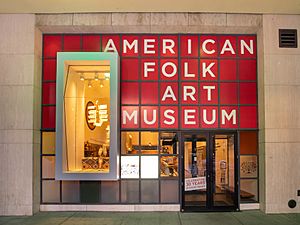
American Folk Art Museum
|
|
| Former name | Museum of Early American Folk Arts |
|---|---|
| Established | June 23, 1961 |
| Location | 2 Lincoln Square Manhattan, New York, United States |
| Public transit access | Subway: Buses: M5, M7, M11, M20, M66, M104 |
The American Folk Art Museum is a special art museum in New York City. It is located in Manhattan, at 2 Lincoln Square. This museum is all about folk art and art made by people who taught themselves.
The museum has about 7,500 art pieces. These artworks range from old folk art to modern art by self-taught artists. The museum shows art made by people who learned to create without formal art school training. Jason T. Busch has been the museum's director since 2018. In March 2025, Newsweek magazine readers voted it the #1 Best Art Museum.
It is free to visit the museum. More than 130,000 people visited the museum in a recent year.
Contents
Museum History and Growth
The American Folk Art Museum started in 1961. Back then, it was called the Museum of Early American Folk Arts. It did not have its own building or a large collection. But its founders, Joseph B. Martinson and Adele Earnest, wanted to share American folk art with everyone.
The museum held its first art show in 1961 in a rented space. In 1962, it received its first gift: a gate shaped like an American flag. At first, the museum focused on art from the 1700s and 1800s from the northeastern United States.
Expanding What Folk Art Means
In 1966, the museum changed its name to the Museum of American Folk Arts. It started to look at folk art in new ways. The museum began to show art from all over America. It also included unique art pieces that were not just traditional or useful. This helped people see folk art in a new light.
In the 1990s, the museum started to show more diverse art. It included artworks by African American and Latino artists. The museum wanted to show how different cultures contribute to American folk art.
In 1998, the museum created the Contemporary Center. This part of the museum focuses on art by self-taught artists from the 1900s and 2000s. It also includes "art brut," which is a type of art from Europe made by untrained artists. In 2001, the museum opened a study center for the self-taught artist Henry Darger. It holds many of his works and materials.
A Global View of Folk Art
In 2001, the museum got its current name, American Folk Art Museum. This name shows that the museum is in America and focuses on American art. However, it also collects and shows folk art from other countries. For example, it has shown art from Latin America, England, and Norway.
Finding a Permanent Home
The museum moved several times to find a permanent home. In 1979, it bought two buildings on West 53rd Street. In 1989, a new branch, the Eva and Morris Feld Gallery, opened at 2 Lincoln Square.
In 2001, a new building opened on West 53rd Street. It was designed by Tod Williams and Billie Tsien. This building was the main museum from 2001 to 2011. However, the museum later sold this building to the Museum of Modern Art (MoMA). MoMA decided to tear down the building in 2014 for its own expansion. Many people were upset about this, but the building was still demolished. Its unique metal front was saved by MoMA.
After the sale, the museum's main location became the facility at 2 Lincoln Square. In 2014, the museum's archives and offices moved to Long Island City, Queens. In 2017, the museum opened the Self-Taught Genius Gallery there. This gallery shows art from the museum's collection in changing exhibits. The STG Gallery is currently closed. The American Folk Art Museum itself temporarily closed in May 2025 for renovations.
Museum Leaders
From 2012 to 2018, Anne-Imelda Radice was the museum's Executive Director. Jason T. Busch took over in 2018. He was named Director & CEO in 2022. Stacy C. Hollander was the chief curator until 2019. Dr. Valérie Rousseau has been the curator of self-taught art since 2013. Emilie Gevalt joined in 2019 and became Deputy Director in 2025.
Art Collection
The museum's collection has over 7,000 art pieces. Most of these artworks were given as gifts. It is known as "one of New York City’s great treasures."
The collection includes many different types of art. You can see early portraits by artists like Sheldon Peck and Ammi Phillips. There are also colorful paintings by Sam Doyle. The museum has quilts, needlework, furniture, and weathervanes. It also features works by famous self-taught artists like Thornton Dial, Morris Hirshfield, Martín Ramírez, Judith Scott, and Bill Traylor.
The museum keeps adding to its collection. Recently, it acquired a version of Edward Hicks's famous The Peaceable Kingdom painting. This painting was owned by Hicks's family for many years. Other new additions include portraits by Sheldon Peck and works by Paul Laffoley and Clementine Hunter. The artist KAWS also donated a sculpture by William Edmondson in 2021.
The museum also received many masterpieces from the Audrey B. Heckler collection. These include works by Aloïse Corbaz, William Edmondson, and Adolf Wölfli. In April 2025, the museum received five important paintings by Morris Hirshfield. These were given by the family of art dealer Sidney Janis.
The museum also has a large collection of historical records. This includes artist files, films, photos, and research materials. It has the biggest collection of materials from the self-taught artist Henry Darger.
Collection Highlights
-
Edward Hicks, Peaceable Kingdom, 1829–1831
-
Hannah Cohoon, Gift Drawing: The Tree of Light or Blazing Tree, 1845
Exhibitions and Shows
Each year, the museum puts on many exhibitions. These shows feature both traditional folk art and contemporary self-taught art. The exhibits often focus on one artist or a specific type of art, like quilts. The museum helps show that art made by self-taught artists is very valuable.
The museum's exhibits help people better understand folk and self-taught artists. Past shows have featured artists like Thomas Chambers and Asa Ames. The museum has also had solo shows for famous self-taught artists. These include Martín Ramírez, Eugene Von Bruenchenhein, Willem van Genk, and Bill Traylor.
Some past exhibits have also connected traditional folk art with modern art. For example, a 2008 exhibit looked at the visual links between paintings by Ammi Phillips and Mark Rothko. In 2013, the museum asked fashion designers to create new works inspired by pieces in its collection. This show was called "Folk Couture: Fashion and Folk Art."
In 2014, the museum launched a traveling exhibition called Self-Taught Genius: Treasures from the American Folk Art Museum. This show had over 100 artworks. It explored the idea of artistic creativity from the 1700s to today. After being in New York, the exhibition traveled to six other cities.
Recent major exhibitions include Morris Hirshfield Rediscovered. This show brought the unique self-taught artist Morris Hirshfield back into the spotlight. The New York Times called it a "critic's pick."
In 2023, the museum presented Unnamed Figures: Black Presence and Absence in the Early American North. This exhibit featured 125 works, including paintings and photographs. It focused on Black figures who appeared in, or were left out of, early American images. The show helped reveal the complex history of the North from the late 1600s to the early 1800s. The New York Times praised it as "a vitally important, deeply moving show."
Awards and Recognition
In 2007, the museum received a $20 million grant from the Carnegie Corporation. This grant was made possible by a donation from New York City mayor Michael Bloomberg.
In March 2025, Newsweek magazine readers voted the American Folk Art Museum the #1 Best Art Museum.
Museum Shop
The museum's gift shop is known as one of the "World's Best Museum Gift Shops" by Condé Nast Traveler. It sells many unique items. You can find handcrafted gifts like jewelry, accessories, and home decor. The shop also offers note cards, books, and exhibition catalogs.
See also
 In Spanish: American Folk Art Museum para niños
In Spanish: American Folk Art Museum para niños





